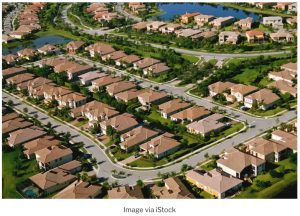Residential Microgrids
Residential Microgrids: What You Need to Know About Going Off the Grid
May 15, 2017 by Megan Wild
 Natural disasters, like Hurricane Katrina and Superstorm Sandy, encouraged the development and installation of residential microgrids in the United States. Microgrids offer increasing benefits to homeowners and small communities as interest in energy independence from power companies continues to grow in response to affordable renewable energy options.
Natural disasters, like Hurricane Katrina and Superstorm Sandy, encouraged the development and installation of residential microgrids in the United States. Microgrids offer increasing benefits to homeowners and small communities as interest in energy independence from power companies continues to grow in response to affordable renewable energy options.
What Are Microgrids?
A microgrid is a local energy grid. It’s located on your property and is connected to your traditional power grid, which delivers the energy for powering your home. Power outages, however, disrupt that delivery. Microgrids, in response, automatically disconnect from the traditional grid and begin powering your home.
Microgrids are powered by batteries, fuel or renewable resources. Because the cost of solar and wind has declined, while the cost of diesel has risen, hybrid microgrids or microgrids exclusively powered by renewable resources are often more cost effective for homeowners. And renewable energy sources, such as solar and wind, rely on traditional power grids to harvest energy. If the traditional grid is offline, they’ll also be offline. A microgrid, though, powers them and can use their energy storages to power your home.
What Are the Benefits of Residential Microgrids?
Residential microgrids offer several benefits to homeowners, especially when they’re a part of a community microgrid. Consider five of the major benefits to residential and community microgrids.
1. Residential Microgrids Lower Energy Costs for Homeowners
Energy is lost every time it’s transmitted and distributed to homes and businesses. It’s estimated that two to 13 percent of energy is lost throughout this process. Microgrids have limited energy loss because they’re located right on your property.
Costs also decrease when microgrids prioritize power sources. A microgrid with access to your renewable energy system and to the traditional grid can use your renewable storage during peak demand times to avoid higher utility costs. You can then rely on the traditional grid during decreased demand, such as in the evening.
Microgrid prices range from a few thousand to over ten thousand dollars for homes. Proper maintenance and management, however, ensures and extends the lifetime of microgrids. Savings in energy costs or even earning money from selling energy over time often covers the cost of microgrids.
2. Residential Microgrids Provide Energy Independence for Homeowners
Microgrids power your home without relying on the traditional grid or power company. You can use your microgrid to provide electricity and power to your home during storms or major power outages. Areas prone to power outages, whether through hurricanes or frequent storms, benefit from microgrids. Homeowners are encouraged to be safe and stay inside, versus leaving their home to find locations with power.
Homes can be exclusively powered by microgrids as well, without any dependence on power companies. Rural homeowners or communities often use microgrids this way. Renewable resources and batteries typically power microgrids independent of traditional grids.
Communities reliant on microgrids can serve as safe havens or evacuation areas for nearby towns. A casino in California, for example, was an evacuation area during a forest fire because it had a microgrid.
3. Residential Microgrids Produce Clean Energy for Homeowners
Reduced solar and wind costs encourage powering microgrids with renewable energy. Solar installation costs, for example, decreased by five percent in 2015. Microgrids using renewable energy also reduce your carbon footprint. Power companies, however, have an extensive carbon footprint. Water and air pollution, as well as the release of greenhouse gases are just three of several environmental impacts from electrical companies.
4. Residential Microgrids Earn Money for Homeowners
Homeowners can earn money, as well as tax credits, for microgrids. If your microgrid uses renewable energy, you can take advantage of the Residential Renewable Energy Tax Credit, which benefits solar, wind and geothermal energy systems.
Power companies also buy excess power from homeowners, especially clean or green energy. Demand for clean energy is higher because companies sell it to consumers at a premium price, called green pricing.
Microgrid communities benefit from selling and buying power within the community. Money from energy sales and purchases also supports your local community’s economy versus a distant power company.
Why Get a Residential Microgrid?
Independence from power companies is a growing trend in the U.S. It’s not uncommon for neighbors to be powering their homes with renewable energy.
Advances in technology make microgrids a feasible option. As a homeowner, you can benefit by lowering your energy costs, while earning money for selling your green energy. If you’re a part of a community microgrid, you’re helping the local economy.
Microgrids offer freedom and security. Natural disasters risk lengthy power outages. Generators are common and more affordable, but rely on your limited supply of gas. And, unlike a generator, you can use your microgrid daily and benefit.
Going off-the-grid is a safe, reliable and beneficial option if you’re interested in an alternative and clean power source for your home, or even community.









